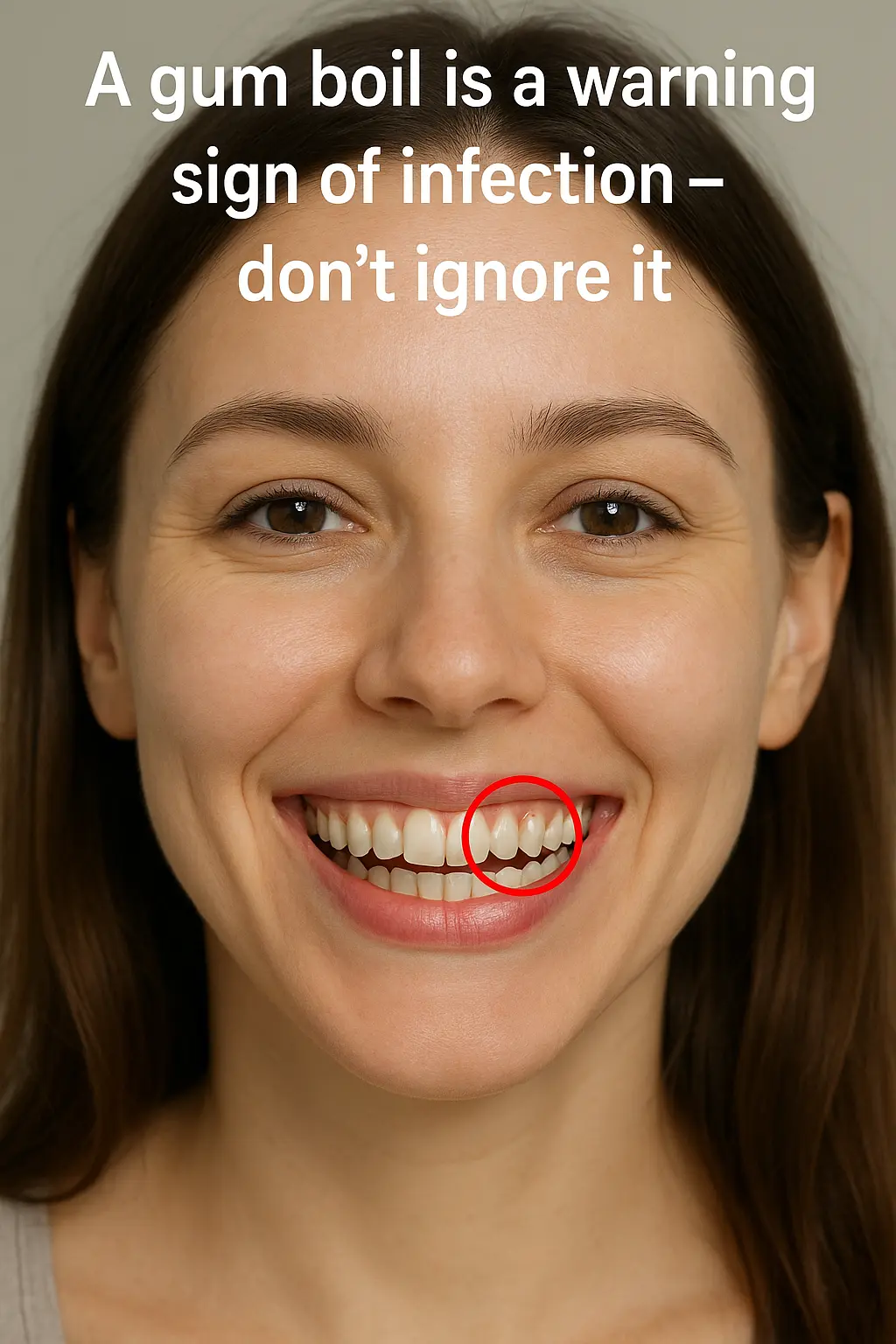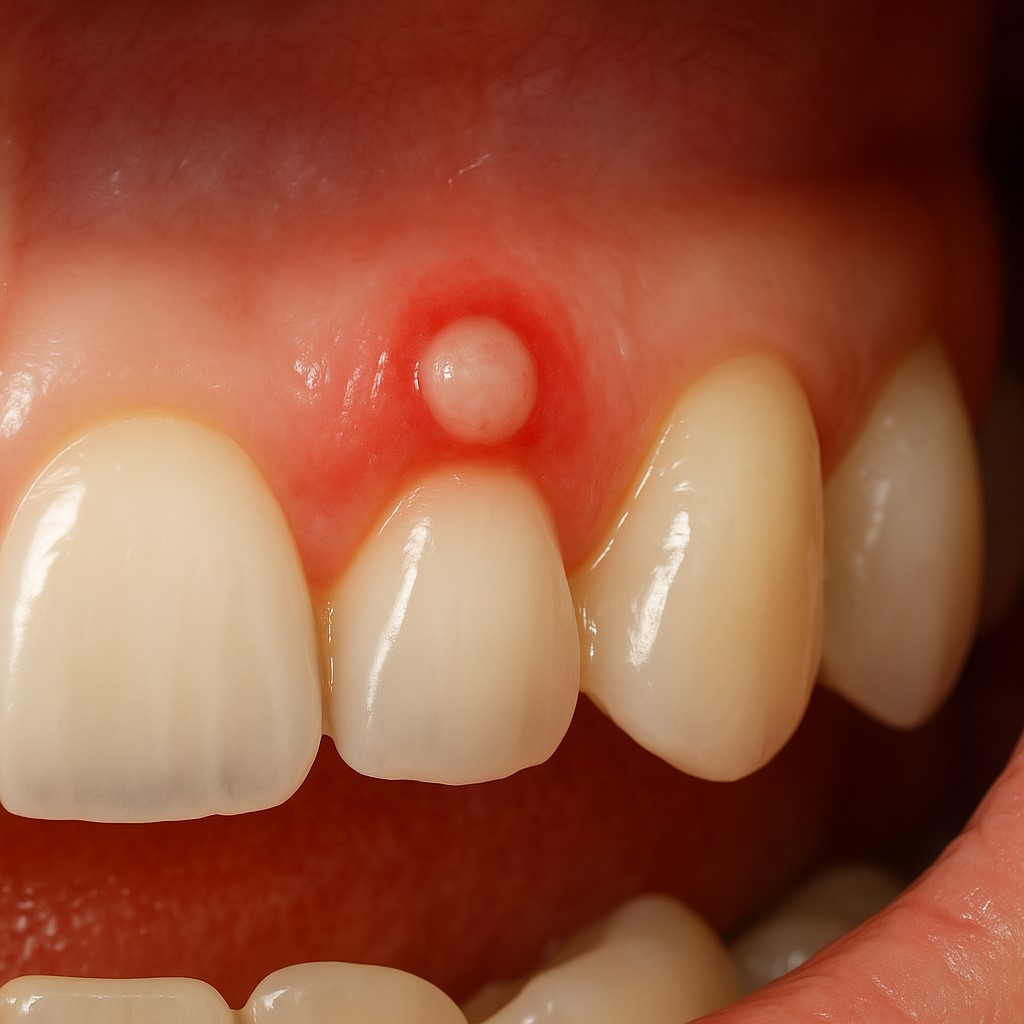A gum boil, sometimes called a “pus-filled bump” or “gum blister,” looks like a small pimple on the gums that is filled with pus. It usually develops as the result of a bacterial infection that builds up underneath the gum surface. This is an important oral health issue because it signals an underlying infection. If left untreated, it may lead to serious complications. Gum boils are especially common in people with advanced gum disease (periodontitis) or a tooth root infection.

Causes of Gum Boils
Gum boils usually develop because of a bacterial infection, and several factors can increase the risk of this happening
Infection-related causes:
When bacteria infect the pulp chamber or gum pockets—often a consequence of severe gum disease or tooth decay—the gums boil. Untreated tooth decay can cause an apical gum boil (tooth root gum boil) to form at the root of the tooth. Similarly, advanced periodontitis (advanced gum disease) can lead to the development of a periodontal gum boil within the gum pocket.
Trauma and external factors:
A hard blow to the tooth or improper dental treatment can also cause a gum boil. Poorly made or leaking fillings and ill-fitting crowns can allow bacteria to seep into the inner parts of the tooth.
General health factors:
A weak immune system can also pave the way for blister formation in the gums and subsequent gum boils. In fact, weak immune systems make it harder for the body to fight off oral bacteria, which increases the risk of infection. Moreover, a major contributor to the likelihood of gum boils is poor oral hygiene, which includes an increase in plaque buildup due to an absence of frequent brushing and flossing. As a result, this, in turn, increases the likelihood of tooth decay and gum disease.
Gum Boil Symptoms

Symptoms that appear in the presence of gum boils are usually indicative of infection. The main symptoms are as follows:
Swelling and inflamed blister:
Either a small, white-yellow blister filled with pus or an obvious swelling develops on the gums. This blister may look like a pimple or a pustule (pus point) and often indicates the exact location of the gum boil. When you press on this gum swelling, it may release pus and feel soft to the touch.
Redness and pain:
The gums and periodontal ligaments surrounding the boil will swell and become sensitive. An ongoing ache, sometimes characterised as excruciating pain or a throbbing sensation, is common. The discomfort could be worse when you chew or if someone touches the tooth that is affected. Experiencing pain is typically the initial sign of a gum boil.
Bad taste or smell in the mouth:
On rare occasions, pus that has developed in the infected area may leak into the mouth, imparting an unpleasant flavour or causing foul breath (halitosis). This inflammation flowing from the gum boil may cause a metallic or salty taste in the area. Additionally, bleeding around the affected tooth due to the gum boil may also occur, which can contribute to abnormal taste and odor in the mouth.
Fever and fatigue:
Depending on the severity of the infection, the body may respond with a general reaction. High fever, chills, swollen lymph nodes, and general weakness may be signs that the infection is spreading. In severe gum boils, the immune system may respond to the infection by raising the body temperature. Symptoms such as feeling sick or tired, or noticing swelling in the lymph nodes in the area, may indicate that the gum boil is no longer localized and has begun to have a systemic effect.
Painless gum boils (asymptomatic gum boils):
There is no hard and fast rule that says all gum boils will hurt. Some are painless, while others show no symptoms at all. Inflammation within the gums can reduce pressure and cause a boil to form if a drainage pathway is not accessible. Just because a gum boil isn't hurting doesn't mean it's insignificant; in fact, it could mean that the infection is sneaking up on deeper tissues. The infection can spread and cause more serious complications if you put off treatment because you are not in pain. For that reason, you shouldn't ignore any unusual swelling in your gums—no matter how slight—and should consult a specialist without delay.
Gingival Blister Diagnosis Methods
A dentist typically diagnoses a gum boil through a clinical examination. Dental X-rays are often used to determine the source of the infection. An X-ray can show the location and severity of the root infection causing the gum boil or the buildup in the gum pockets. Usually, the dentist will request an X-ray to see if the gum boil has caused damage to the surrounding bone. 3D imaging (CT scan) also provides more comprehensive information about the size of the gum boil and whether it has spread to areas such as the neck. In addition, the dentist may test the vitality of the tooth in the area of the gum boil, as a dead tooth nerve is often associated with an apical gum boil.
Gum Boil Treatment Options
A gum boil may look small, but it's a loud warning sign from your body. The main goal in treatment is simple: clear the infection and stop it from coming back. That's why professional care is essential. Sometimes the dentist drains the boil, sometimes a root canal or deep cleaning is needed — and in severe cases, the tooth may have to go.
Antibiotics can help prevent the spread, but they're never a cure on their own. Painkillers or mouth rinses might ease discomfort, yet only real dental treatment solves the problem. With the right care, symptoms shrink within days, but lasting recovery demands one thing above all: consistent oral hygiene.
Gum Boils: Temporary Measures You Can Take at Home
The conclusive remedy for gum boils necessitates dental intervention. There are, however, some home remedies that may alleviate pain and prevent infection that you can try in the interim.
Warm saltwater gargle:
Rinsing your mouth multiple times daily with salt water—made by mixing half a teaspoon of salt with a glass of warm water—can alleviate the swelling and pain caused by gum boils.
Oral hygiene:
Maintaining good oral hygiene is critical at all times, but especially when dealing with a gum boil. Use a gentle bristle brush to carefully clean your teeth, paying special attention to the area where the gums are boiling. If at all possible, keep flossing as well. Stay away from the boiling gum and don't pop it either.
Cold compress:
Never use a hot compress on a swollen area around a gum boil; instead, use a cold compress. Yet, a cold compress may provide temporary relief from pain and swelling.
Pain management:
Over-the-counter painkillers (such as ibuprofen or paracetamol) can help provide temporary relief.
Important: Do not try to pop or squeeze a gum boil at home. This can spread the infection deeper into the tissues and cause serious complications.
Frequently Asked Questions
How can I get rid of a gum boil?
To get a permanent fix, it's hard to do it yourself. Saltwater gargles and other home cures are only effective for a short while. For the gum boil to heal completely, the dentist must drain the infection and perform the necessary treatments.
What causes a gum boil?
Having a bacterial infection is the leading cause. Deep cavities, tooth root infections, or advanced gum disease (periodontitis) can lead to gum boils. Additionally, blows to the tooth, improper dental procedures, or a weakened immune system can also contribute to this condition.
How long does a gum boil last?
If left untreated, a gum boil will not disappear on its own and can last for weeks or even months. After a few days of treatment, it will shrink considerably and the discomfort will go away. On the other hand, if the gum boil is particularly severe, full tissue healing could take weeks.
Is it okay to squeeze or pop a gum boil?
Absolutely not! This ought not to be done in any way. Popping or squeezing the gum boil region might push the infection deeper into the body. Having a dentist sterilely drain the gum boil is the safest and most effective option.
Are gum boils dangerous?
Yes. If left untreated, gum boils can grow and damage tooth and bone tissue, and may even lead to tooth loss. Worst of all, the infection has the potential to enter the bloodstream and cause major harm by affecting important organs like the brain, heart, or lungs.
Is a gum boil an emergency?
In most cases, yes. This situation necessitates immediate intervention, particularly in the presence of fever, intense pain, and rapidly spreading facial swelling. Regardless of the mildness of the symptoms, it is imperative to regard the gum boil with seriousness and consult a dentist promptly.
Do gum boils go away on their own?
No. Sometimes the gum boil may burst and shrink, but it will recur unless the source of the infection is treated. For permanent healing, the dentist must clean the infection in the gum boil and eliminate the underlying cause.
Are gum boils common?
It is quite common. They tend to show up more often in patients who have severe cavities or gum disease. Those who neglect their dental health are at a higher risk.
Is a painless gum boil dangerous?
Just because it doesn't hurt doesn't imply it's risk-free. Sometimes gum boils do not cause pain because they reduce pressure through drainage. The infection can, however, spread undetected in this instance. If you notice any swelling or a boil in your gums, you should see a dentist right away, even if you're not experiencing any pain.
Conclusion
A gum boil is an infection that requires immediate attention. Seeing a dentist early on both quickly reduces pain and prevents the infection from spreading. Regular oral care and check-ups greatly reduce the risk of this problem occurring.
